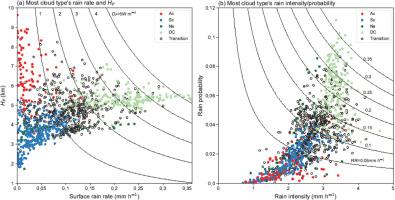一种识别热带地区主要云型及云型与降水垂直结构关系的新方法
IF 3.2
4区 地球科学
Q3 METEOROLOGY & ATMOSPHERIC SCIENCES
引用次数: 0
摘要
云型对降水有深刻的影响,但对其对降水尺度高度影响的研究较少。作者计算了每种云类型的体积占总云量的比例,并根据主要云类型划分了热带地区。在此基础上,将热带地区划分为高积云控制区、层积云控制区、深对流云控制区和过渡区。这些区域具有独特的特点:高积云控制区降水尺度高度高,地表降水率低;层积云控制区降水尺度高度低,地表降水率低;深对流云区降水率高,降水尺度高度中等。这些特征是由于云特征、降水概率和强度的差异,受到不同的水汽结构的影响。在物理机制上,高积云区、层积云区和深层对流云区分别表现为全干、高层干低层湿和总湿。上层干燥导致低层云和降水结构,使降水尺度高度降低,下层干燥使降水尺度高度升高。不同的上下层湿度条件导致云型和体积分布的变化,最终影响降水尺度高度。这一发现有助于热带云降水物理的机理研究,为发展数值模式和参数化提供有价值的见解。摘要云类型对降水有重要影响, 但其对降水尺度高度的作用研究尚少. 本研究通过计算各云类型体积占总云体积的比例, 将热带地区划分为高积云, 层积云, 深对流云控制区及过渡区. 高积云区降水尺度高度较高, 地表降水率较低; 层积云区降水尺度高度和地表降水率均较低; 深对流云区降水尺度高度适中, 地表降水率较高. 这些特征由云特性, 降水概率和强度的差异决定, 并受到水汽结构的影响. 高积云, 层积云和深对流云区分别表现为整体干燥, 上层干燥且下层湿润, 以及整体湿润的特征. 上层干燥降低降水尺度高度, 下层干燥则升高高度. 上下层湿度差异影响云类型分布和降水结构, 最终决定降水尺度高度. 本研究为云降水物理机制研究及数值模式开发提供了新视角.本文章由计算机程序翻译,如有差异,请以英文原文为准。

A new approach for identifying dominant cloud types and relationships between cloud types and precipitation vertical structure in tropical regions
Cloud type profoundly affects precipitation, but few studies have explored its impact on precipitation scale height. The authors calculated the ratio of the volume of each cloud type to the total cloud volume and partitioned the tropical region based on the dominant cloud types. Based on this, tropical regions were categorized into altocumulus control regions, stratocumulus control regions, deep convective cloud control regions, and transition regions. These regions exhibit unique characteristics: high precipitation scale heights and low surface precipitation rates in altocumulus control regions; low precipitation scale heights and low surface precipitation rates in stratocumulus control regions; and moderate precipitation scale heights with high surface precipitation rates in deep convective cloud regions. These features arise from differences in cloud characteristics, precipitation probability, and intensity, influenced by varying water vapor structures. In terms of physical mechanisms, altocumulus, stratocumulus, and deep convective cloud regions are characterized by total dryness, upper-level dryness with lower-level wetness, and total wetness, respectively. Upper-layer dryness leads to low cloud and precipitation structures, reducing the precipitation scale height, while lower-layer dryness increases it. Different humidity conditions in the upper and lower layers lead to variations in cloud type and volume distribution, ultimately affecting precipitation scale heights. This finding aids the mechanistic study of cloud precipitation physics in the tropics, providing valuable insights for developing numerical models and parameterizations.
摘要
云类型对降水有重要影响, 但其对降水尺度高度的作用研究尚少. 本研究通过计算各云类型体积占总云体积的比例, 将热带地区划分为高积云, 层积云, 深对流云控制区及过渡区. 高积云区降水尺度高度较高, 地表降水率较低; 层积云区降水尺度高度和地表降水率均较低; 深对流云区降水尺度高度适中, 地表降水率较高. 这些特征由云特性, 降水概率和强度的差异决定, 并受到水汽结构的影响. 高积云, 层积云和深对流云区分别表现为整体干燥, 上层干燥且下层湿润, 以及整体湿润的特征. 上层干燥降低降水尺度高度, 下层干燥则升高高度. 上下层湿度差异影响云类型分布和降水结构, 最终决定降水尺度高度. 本研究为云降水物理机制研究及数值模式开发提供了新视角.
求助全文
通过发布文献求助,成功后即可免费获取论文全文。
去求助
来源期刊

Atmospheric and Oceanic Science Letters
METEOROLOGY & ATMOSPHERIC SCIENCES-
CiteScore
4.20
自引率
8.70%
发文量
925
审稿时长
12 weeks
 求助内容:
求助内容: 应助结果提醒方式:
应助结果提醒方式:


